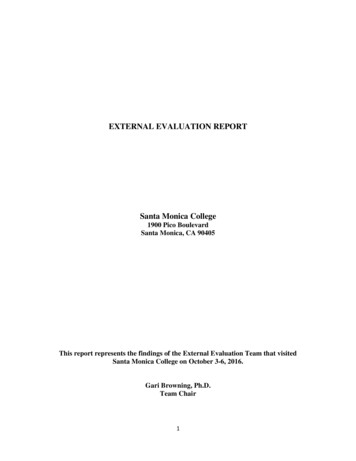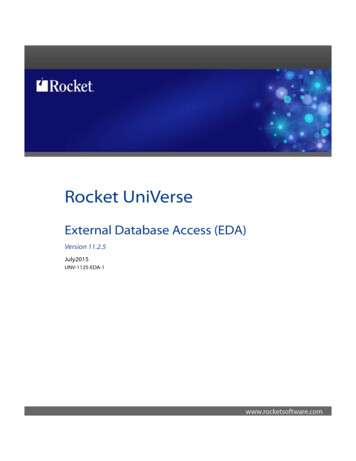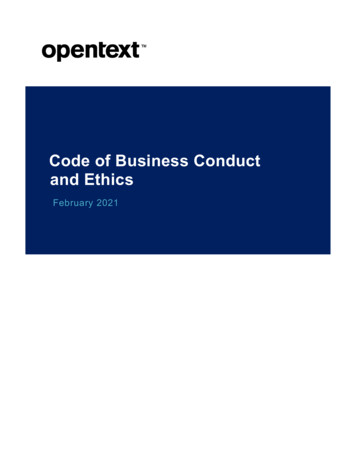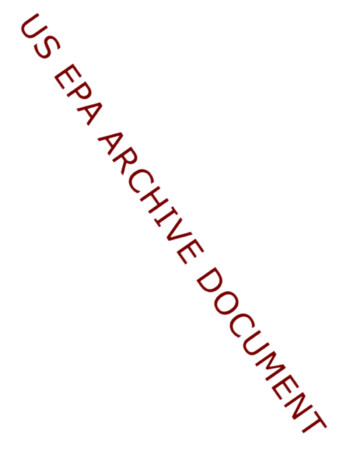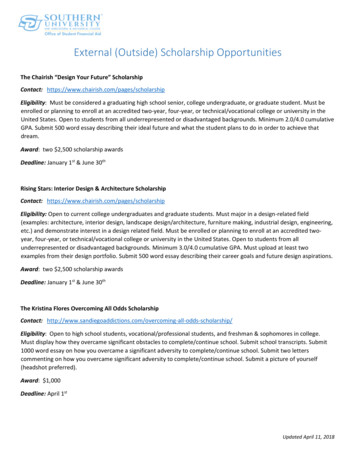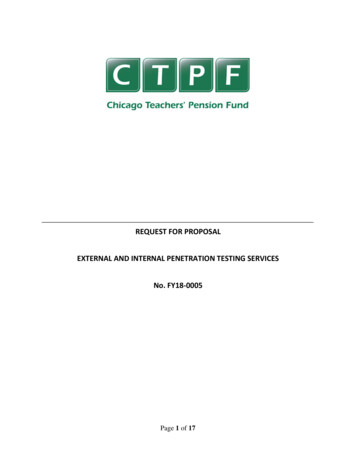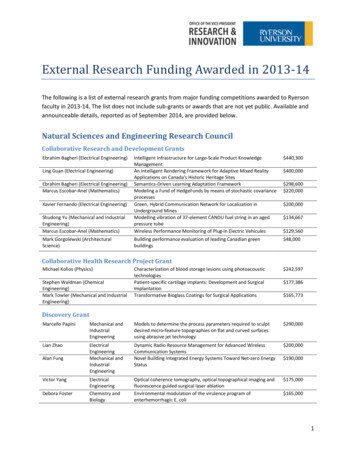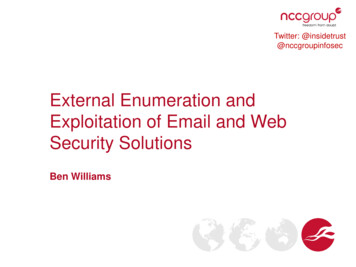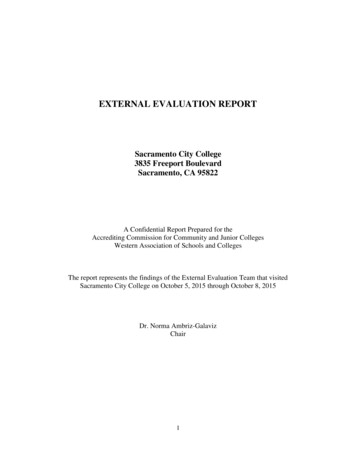
Transcription
EXTERNAL EVALUATION REPORTSacramento City College3835 Freeport BoulevardSacramento, CA 95822A Confidential Report Prepared for theAccrediting Commission for Community and Junior CollegesWestern Association of Schools and CollegesThe report represents the findings of the External Evaluation Team that visitedSacramento City College on October 5, 2015 through October 8, 2015Dr. Norma Ambriz-GalavizChair1
NOTE: this page shall be added to the team report noted below, immediately behind thecover page, and shall become part of the final evaluation report associated with the review.DATE:January 8, 2016INSTITUTION:Sacramento City College3835 Freeport BoulevardSacramento, CA 95822TEAM REPORT:Comprehensive Evaluation ReportThis report represents the finds of the evaluation team that visited Sacramento City CollegeOctober 5-8, 2015.SUBJECT:Commission Revisions to the Team ReportThe comprehensive External Evaluation Report provides details of the team’s findings withregard to the Eligibility Requirements, Accreditation Standards, and Commission policies, andshould be read carefully and used to understand the team’s findings. Upon a review of theExternal Evaluation Report sent to the College, the Sacramento City College Self-EvaluationReport, and supplemental information and evidence provided by the College, the followingchanges or corrections are noted for the Team Report:1. The Commission finds that the District is not out of compliance with Standard III.C.1, andthat Standard reference should be removed from District Recommendation 1.2. The Commission finds that District Recommendation 3 should be written as arecommendation to meet Standards rather than an improvement recommendation.3. The Commission has found the College out of compliance with ER 16 and has added thatthat citation to College Recommendation 2.2
Visiting Team MembersDr. Norma Ambriz-Galaviz (Chair)PresidentMerritt CollegeMs. Stefanie Harding (Assistant)Staff AssistantMerritt CollegeMs. Evelyn LordHead LibrarianLaney CollegeDr. Tim HarrisonDean of Athletics, Health, Kinesiology, & Off Campus ProgramsVentura CollegeDr. Tanya RennerProfessor of PsychologyKapiolani Community CollegeDr. Diane DieckmeyerVice President, Academic AffairsNorco CollegeMs. Jonna SchengelPhysical Therapist Assistant Program DirectorCollege of the SequoiasMs. Virginia GuleffVice President, Education and Student ServicesMendocino CollegeMs. Deborah IkedaPresidentClovis Community CollegeMr. Richard PagelVice President, Administrative ServicesOrange Coast CollegeDr. Mallory NewellSupervisor, Institutional Research and PlanningDe Anza College3
Summary of the ReportINSTITUTION:Sacramento City CollegeDATE OF VISIT:October 5, 2015 through October 8, 2015TEAM CHAIR:Dr. Norma Ambriz-GalavizPresident, Merritt CollegeAn eleven-member Accreditation Visiting Team was present at Sacramento City College fromOctober 6, 2015 through October 8, 2015 for evaluating the college’s request for reaffirmation ofaccreditation. In preparation for the visit, the team chair attended a team chair-training workshopon July 9, 2015 along with the three other chairs for the Los Rios visiting teams. The chair andteam assistant conducted a pre-visit to the college and the District office on August 14, 2015.During the pre-visit, the chair and team assistant met with District and College leadership andkey personnel involved in the self-evaluation preparation process. The entire evaluation teamreceived team training provided by staff from the Accrediting Commission on September 1,2015. The evaluation team received the college’s self-evaluation in late August and earlySeptember prior to the October 2014 visit, and team members found it to be comprehensive andaddressed all standards including the Commission’s eligibility requirements, commissionpolicies, and pertinent federal regulations.Sacramento City College is one of four colleges in the Los Rios Community District.The Visiting Team found the Self-Evaluation to be well written, documented, and organized.The evidence was imbedded with active links within each the standard description and at theconclusion of each major standard. The majority of the team’s time was spent verifying andreviewing the evidence.The Visiting Team found Sacramento City College to comply with all Eligibility requirements,relevant Commission policies and relevant Federal regulations. The team assessed the college’sresponse to the 2009 recommendations, reviewed follow-up reports, and found that the collegehas made great progress in meeting the recommendations.The team confirmed that the entire Campus community including faculty, staff, students, andadministration compiled the Self Evaluation Report through broad participation. Severalmembers of the Sacramento City College Evaluation Team, along with members from the otherteams visited the with the Chancellor, District staff, and Board members at the District office onMonday October 5, 2015 prior to arriving on the campus of the Sacramento City College.Sacramento City Visiting Team members met with District staff to assess areas such as finance,physical facilities, human resources, technology resources, governance, and Board relations forthe operation of the District. Meanwhile, the rest of Sacramento City Visiting Team members4
visited off campus locations; Davis Center, West Sacramento Center, and the McClellanoutreach site (Aeronautics) facilities.Upon arrival at the campus, the College invited team members to attend an open “meet andgreet” reception with approximately 75 attendees. Members from all constituencies were presentincluding students. Members of the team toured the campus. Some tours were customized basedon specific sites of interest, i.e. sports stadium, new Student Services Building, Routh Hall north,LRC (Library), College Bookstore, and City café. The college is nearly one hundred years old inits current location. The team found that the College’s Facilities Master Plan of 2003-04 andpassing of local facilities bond Measure A in 2002, allowed the College to embark on amodernization and parking improvement program to span the next decade and beyond. In 2007,a significantly large parking garage of 1,958 spaces was completed; in 2005, the modernizationof Technology building followed in 2006 by the Cosmetology building, in 2008 the NorthGymnasium, and in 2010 the Fischbacher Fine Arts building. In the 2014-15 academic year, thecollege completed a remodel of a portion of the Lusk Building and relocated the ElectronicsTechnology program from Rodda Hall North, 3rd floor, to the new space. Currently in 2015,Rodda Hall North 3rd floor is undergoing a remodeling project with plans to house theMathematics, Statistics, and Engineering Division Office and the entire mathematics faculty.Overall, the Team was impressed and found the grounds and buildings well maintained andsupportive of a learning environment.As stated earlier, the college’s three off campus sites were visited and an assessment made on theeach site: West Sacramento, Davis, and McClellan. The West Sacramento and Davis Centers arenewly constructed educational centers with state of art learning facilities. The McClellan facilityis an outreach and learning site for the Aeronautics program of the college. A detailed summaryof the team’s findings for each of the sites is included at conclusion of this report as appendices.The college has maintained enrollment for the past five years in the range of 22,800 to 23,500students. The largest age group is 18-20 years of age with 35.7% and 21-24 years of age at24.9%. Female students represent over 55% of the student body. The college is ethnicallydiverse with no group larger than 30% represented. The college has experienced a significantgrowth since 2010 with the Hispanic/Latino population. As of 2012, the college exceeded the25% federal designation threshold to serve as a Hispanic Serving Institution. As of 2014,Sacramento City College has served over 62% from low to below poverty income levels. TheCalifornia Community College Chancellor’s Scorecard persistence rate of 2014 ranged from 7677% (04-05; 05-06; 06-07; 07-08). Lastly, the number of degrees certificates steadily increasedfrom 1,598 in 2009-10 to 2,145 in 2013-14.During the visit, the team held numerous meetings and interviews with college committees, staff,faculty, students, and administration. Two opportunities (day and evening) for the collegecommunity to meet with members of the evaluation team in Open Forums provided anopportunity for dialogue with Visiting Team members. Team members attended some regularmeetings held on the campus during the visit for example, Academic Senate meeting, AssociatedStudent Body, Student Learning Outcomes Committee, Curriculum Committee, TechnologyCommittee. These visits and meetings allowed the team to gain an understanding of the5
organizational and governance structure of the College. Several team members attendedmeetings with the college’s standard team members used during the college’s processes ofdeveloping its Self-Evaluation Report. In addition, the team observed several class sessions,both face-to-face and online. Team members met with several students, both formally ininterviews and informally in conversations around Campus. These interviews were largelypositive and enlightening for the team. The team greatly appreciated the enthusiasm and supportfrom college during the visit.Clearly, the College has done great work especially in the improvement of learning outcomesassessment, program review and institutional planning, and in engaging the collegeconstituencies in dialog regarding data-informed improvement and decision-making. Thevisiting team found the College engaged, promoting the diversity of its students, and focused onstudent success.Overall, the College and District offices were well prepared for the team's visit and could nothave been more welcoming and hospitable. Understanding of the accreditation process waswidespread throughout the district and college. The Team found requests were met quickly, andemployees were open and candid in their responses to team members’ questions.The team’s workroom was well equipped with excellent technology support and workspaces.The College provided a team workroom at the hotel as well, and provided for Wi-Fi in the teamworkroom and in each team member’s hotel room.6
IntroductionFounded in 1916 as a department of Sacramento High School, Sacramento City College is theseventh oldest public community college in California and the oldest institution of higherlearning in Sacramento. On March 19, 1964, Sacramento City College separated from theSacramento City Unified School District to join the newly organized Los Rios Junior CollegeDistrict, which assumed the operation of American River College and Sacramento City College.In 1926, the College transferred its permanent campus. The first new buildings consisted ofadministration, classrooms with laboratory units, and a gymnasium. With expansion came thedemand for more buildings and more facilities constructed between 1928 and 1965. The collegemaintained a commitment to appropriate learning facilities; thus, since the 1980’s, modernizationof various buildings has occurred. The main campus encompasses approximately 73 acres andconsists of 27 buildings, nearly 500,000 assignable square feet including a newly remodeledstadium that meets seismic and ADA requirements. Increased enrollment growth resulted in theaddition of two off-campus centers, one in Davis and another in West Sacramento.The College currently serves approximately 24,000 students within and outside it downtowngeographic area. Although the campus has experienced a slight decline in the younger studentpopulation (19-20), the group is projecting to rebound in the early 2020s. The Latino studentpopulation continues in an upward trend, and it recently allowed Sacramento City College togain the federal status of Hispanic Servicing Institution.The College offers an array of instructional program and general education course offeringwhich represent 94 Associate Degrees, 22 Associate Degrees for Transfer (ADTs) and 84Certificates of Achievement. Some are available in both face-to-face and online modes. Asignificant number of career technical programs offered at Sacramento City College haveadditional accreditation requirements through their industry or licensure requirements, forexample; The Occupational Therapy Assistant Program, Physical Therapist Assistant Program,Associate Degree Nursing Program, Vocational Nursing Program, Dental Assisting Program,and the Dental Hygiene Program.The College Strategic Planning Committee (CSPC) along with the Office of Planning Researchand Institutional Effectiveness (PRIE) assure the on-going systematic planning, program reviewfor currency, student learning outcomes, and broad based participation from the variousdepartments and divisions. CSPC develops the annual first steps in the planning process, and thecommittee’s membership consists of the leaders of each of the four constituent groups andadministration. Dialogue is encouraged throughout the college to assure effective planning. TheCollege’s Blue Book describes the participatory decision-making process. It outlines theadministrative structure and process, the constituent groups, a committee system along withbylaws and the opportunity for any individual or group in the college to bring forward issues,concerns or recommendations for improvement. Written materials such as agendas and minutesare a standard and made available on the College’s website.7
The college had its most recent comprehensive evaluation and site visit in 2009. Since that visit,it has submitted a Midterm Report 2012 addressing the recommendations from the 2009 visit.Also, noted are the regular substantive change reports submitted to the commission since 2008for a new program, distance education or new teaching centers.In response to previous accreditation recommendations, the college designated the CampusDevelopment Committee in evaluating its planning process for capital projects and resulting inthe sharing of information at Convocation and Executive Council meetings on a consistent basis.A new system called Alfresco was implemented to store content information and is available toincrease access of information. Associated with improving communication was the developmentof the college website. Since spring 2014, Sacramento City College publishes it web informationon their new content management system using WordPress. The college also realized the need toemploy a webmaster to work with staff on maintaining sites as well as working collaborativelywith the college Public Information Office for marketing and/or red-designing programdescriptions.Lastly, Sacramento City College embraces Student Learning Outcomes andactively assesses courses, programs, general education, student services and administrative units.Data analysis is widely incorporated into various venues for dissemination and discussionthroughout the campus as depicted the CCSSE survey.8
College/District CommendationsCollege CommendationsCommendation #1The College is commended for the opportunities and support it provides for its diverse studentpopulation as evidenced by its Cultural Awareness Center (CAC) which sponsors free“educational and intercultural programs” including “speakers, films, community forums, bookreviews and diversity workshops that are designed to promote advocacy, inquiry and inclusion.”Commendation #2The Student Senate is commended for its active engagement in the participatory governanceprocess and for its leadership in empowering students to address campus issues.Commendation #3The library website is a vibrant, accessible, student-friendly portal to library resources andsupport services. The site is clear and well organized. Engaging graphics, including book jacketsin the online catalog, promote student use. Among the site’s notable features are the tabbedsearch box, the OneSearch interface, Ask a Librarian chat reference, and the nationallyrecognized PILOT (Path to Information Literacy Online Tutorial).Commendation #4The College is commended for its development, planning, and implementation of the newlyconstructed Davis and West Sacramento Centers. The innovative partnerships, the commitmentof resources, as well as the dedication to programming and student services provide anoutstanding educational environment for students of the surrounding communities. These qualityfacilities have set a new standard for future California Community College Centers.District CommendationsCommendation #1The College and District should be commended for fully recognizing and funding the Other PostEmployment Benefits (OPEB) obligations. The College and District have been funding theOPEB since the 1980s resulting in fully funding and providing an ongoing line item budget forfuture obligations.Commendation #2The District is to be commended for the Chancellor’s Cabinet, which includes all constituenciesand provides for transparency in decision-making related to budget, strategic planning, BoardPolicies and Regulations, and other important areas affecting District and College operations.(IV.B.3, IV.B.3.a, IV.B.3.c)9
College/District Recommendations to Meet StandardsCollege RecommendationsCollege Recommendation #1In order to meet the Standards, the Visiting Team recommends the College develop a system toensure that students receive course syllabi that contain learning outcomes that are consistent withthose in the institution’s officially approved course outlines of record. (II.A.6)College Recommendation #2In order to meet the Standards, the College should move from a pilot online tutoring program toa fully implemented online tutoring program to provide the same services to all studentsregardless of location or means of delivery. (II.B.1, II.B.3.a, II.C.1, II.C.1.c)Recommendation #3In order to improve institutional effectiveness, the College needs to move forward on the actionplan it identified by utilizing the Blue Book Task Force for making recommendations to helpimprove participatory decision-making processes and enhance college-wide communication.(IV.A.1, IV.A.2, IV.A.2.a, IV.A.2.b, IV.A.3)District RecommendationsDistrict Recommendation #1In order to meet the Standards, the District Evaluation Team recommends that the LRCCDdevelop a comprehensive Technology Plan for the District. The plan should be integrated withthe program review process and with the on-going and routine technology assessments done byDistrict Information Technology. The Technology Plan should align with and directly supportthe District Strategic Plan and the colleges’ strategic plans. Finally, the plan will need to beroutinely assessed and updated to ensure currency. (III.C.2)District Recommendation #2In order to meet the Standards, the District Evaluation Team recommends that the LRCCDdevelop a clearly-defined policy for selecting and evaluating the presidents of the colleges.(IV.B.1.j)District Recommendation #3In order to meet the Standards as well as to improve institutional effectiveness and align policywith practice, the District Evaluation Team recommends that the District modify the existingBoard Policy 4111 to more clearly define that the Chancellor delegates full responsibility,authority, and accountability to the presidents for the operations of the colleges. The EvaluationTeam further recommends that Section 1.2 of Board 2411, which establishes the role of thePresident as the chief college administrator, be added to the policy section 4000 –Administration. (IV.B.2.c, IV.B.3.b, IV.B.3.e)10
Evaluation of Institutional Responses to Previous Recommendations2009 Recommendation #1 - Student Learning OutcomesIn order, to fully meet the Standards, the team recommends that the College build on thestrong foundation it established in identifying Student Learning Outcomes (SLOs
Laney College Dr. Tim Harrison Dean of Athletics, Health, Kinesiology, & Off Campus Programs . of Technology building followed in 2006 by the Cosmetology building, in 2008 the North Gymnasium, and in 2010 the Fischbacher Fine Arts building. . The college has maintained enrollment
